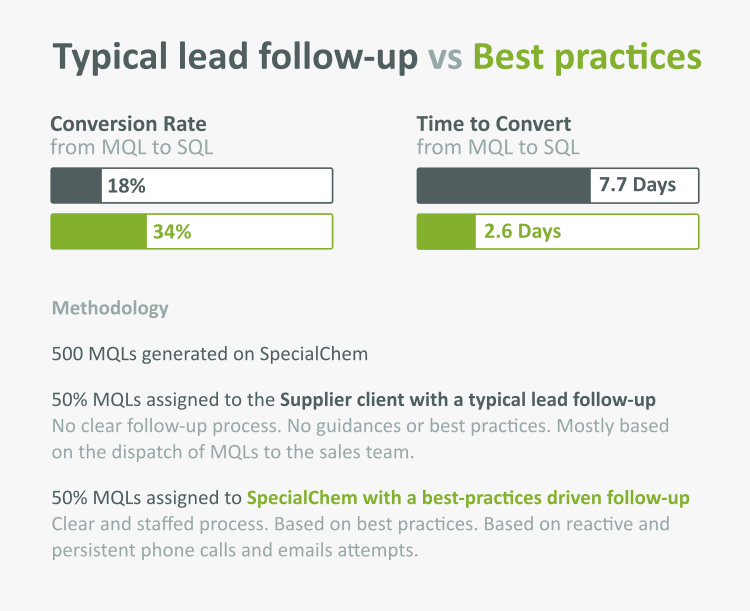Bad vs Good lead follow-up: the impact on your conversion rate
At SpecialChem we generate digital leads for suppliers of specialty chemicals and materials.
These digital leads must be followed-up and qualified in order to identify the ones that are real business opportunities. The highest quality leads will align with your target by having a need or project that is suitable for your product, and are ready to move forward with your sales team.
We even follow-up and qualify the leads for some of our clients, especially when they are unfamiliar with an effective lead conversion process or lack resources to do it effectively.
Here is what we found after comparing a typical lead follow-up process vs the best practices we have learned:

To compare the efficiency of each lead follow-up process, we randomly assigned 50% of MQLs (Marketing Qualified Leads) generated on SpecialChem to our supplier client and assigned the other 50% to our SpecialChem Qualification Team.
With this lead pool split 50/50, we confirmed that each had the exact same lead quality, and SpecialChem was able to qualify twice as many MQLs versus our supplier client.
Slow follow-up is a primary red flag indicating a bad process and is one of the greatest contributors to low conversion rates. But I’ll give more details in the next sections.
If you want to maximize the ROI of your lead generation actions, you need to implement an effective lead follow-up process, or you will waste a significant value of your investment.
What is bad lead follow-up?
We have seen across the board that a vast majority of suppliers use the same typical “process” to follow-up their leads to convert them into customers.
And mind the quotation marks when I say “process”, because I mean NO process at all.
So here is what a typical lead follow-up “process” looks like at suppliers’ organization:
- The leads are generated by interacting with your content on SpecialChem, UL Prospector®, your website and other sources.
- Based on region, the leads are then assigned and dispatched to the regional sales reps.
- If they have time when not focusing on current customer needs, the sales reps will screen the leads list and decide whether to follow-up or not. This is why 23% of leads are followed-up at this stage according to InsideSales.
- When available, the salesperson will send an email to the lead, usually after 1 full week has passed from the initial inquiry. According to InsideSales, 70% of attempts are made AFTER the first week as passed.
- The lead doesn’t respond. The salesperson doesn’t persist for many reasons including lack of time, lack of best practices, not a priority, outside the comfort zone, etc.
- The lead is cold.
- The sales reps complain about the poor lead quality. AND THEY ARE RIGHT.
If you use this follow-up “process” at your company, you should really consider implementing a robust best-in-class lead follow-up as you are wasting most of your lead generation ROI.
Plus, you are exhausting your sales team with inefficiency, which is discouraging for anyone who’s success is measured by new business closed.
What is a good lead follow-up?
If you want to double your conversion rate, I recommend you apply these lead follow-up best practices, which we use with our SpecialChem clients who have engaged us to do the MQL > SQL conversion for them.
In a nutshell, you need to:
- Make your lead follow-up a real process in your organization with a person dedicated to qualify all your MQLs. Only the opportunities that this person has pre-identified from the MQL pool make it to the sales team. This is the key differentiator between a bad and a good lead follow-up.
- Screen all your leads to detect the MQLs to qualify among them. A good lead scoring process will help you ease this painful task.
- Be reactive and call your MQLs as soon as possible. This means picking up the phone within the first 1h to 24h for all requests! Send emails right away if they don’t answer your call attempts. Emails are more easily ignored and lost. Phone calls and voicemails put the human relationship at the forefront, and this is the first impression to build trust with the person on the other side.
- Don’t sell your products at this stage. You are here to understand if your MQL has a need or project suitable for your product, and verify that the lead is in your target. Share expertise instead and ask the questions that help you to determine the fit with this person. Prepare case studies to help you with “story-telling” on what similar problems you have solved in the past.
- Personalize your communication to increase your chance to receive a reply. Use the content the MQL has seen or downloaded, or use the related topics as hooks for example.
- Mix channels, combine phone calls and emails to maximize your chance for a reply.
- Be persistent and don’t give up on the first attempt. Make 6 attempts within the first week.
- Track your conversion performance. You can only improve what you measure.
- Manage your expectations. It is impossible to reach out 100% of your MQLs. A high conversion rate will be between 30-40%.
Get the full in-depth review on these 9 lead follow-up best practices here.
